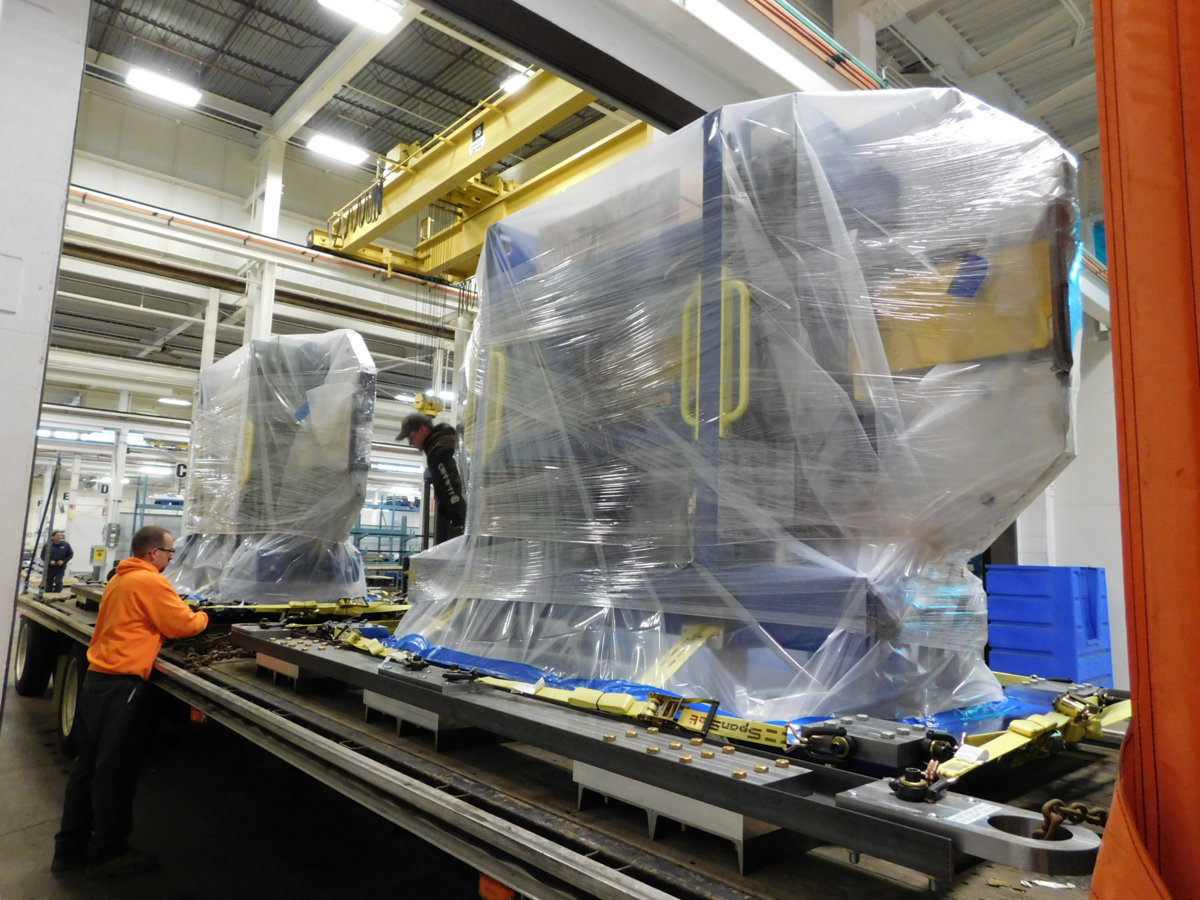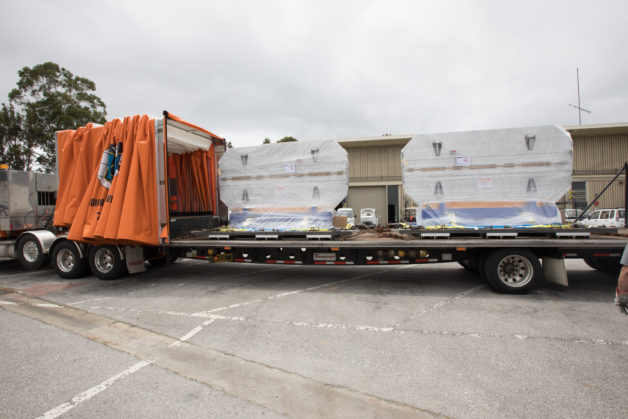
The first two undulator segments—devices that will be used to produce X-ray laser beams for a project known as LCLS-II—arrived at SLAC National Accelerator Laboratory in Menlo Park, Calif., on Wednesday. (Credit: SLAC National Accelerator Laboratory)
The first shipment of powerful magnetic devices for a next-generation laser project arrived at SLAC National Accelerator Laboratory on Wednesday after a nearly 3,000-mile journey from a factory in New York to California in a customized delivery truck.
The Department of Energy’s Lawrence Berkeley National Laboratory (Berkeley Lab) is overseeing the development and delivery of these devices, known as soft X-ray undulators. They are a key part of LCLS-II, a free-electron laser being built for SLAC by a partnership of SLAC and four other DOE national laboratories: Berkeley Lab, Fermilab, Jefferson Lab, and Argonne.
The two devices that arrived this week to LCLS-II are the first of what will ultimately be a chain of 21 segments making up the complete soft X-ray undulator. They are at the heart of the free-electron laser, as they will cause the high-energy electron beam from a linear accelerator to emit laserlike beams of X-rays.
The soft X-ray undulator units present an impressive combination of brute strength and fine precision. Each weighs about 6.5 tons and is about 11 feet long, with sturdy steel frames that are designed to withstand nearly 7 tons of force to keep the two rows of magnets precisely positioned as they try to repel each other. The distance between the rows can be adjusted within millionths of an inch to tune the properties of the X-ray laser light.
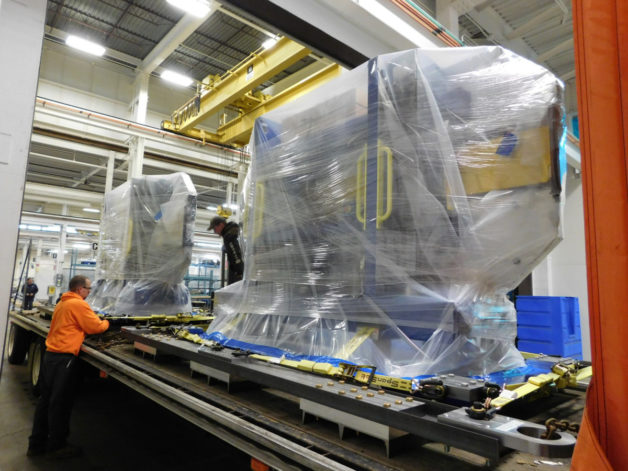
Workers at KTC, a company in Buffalo, N.Y., prepare the first powerful magnetic devices known as soft X-ray undulator segments for the cross-country journey to SLAC National Accelerator Laboratory in Menlo Park, Calif. Berkeley Lab is overseeing the development and delivery of these segments for use in the LCLS-II project, an upgrade to SLAC’s X-ray laser. (Credit: Keller Technology Corp./KTC)
LCLS-II is a major new facility and upgrade to the existing Linac Coherent Light Source, a DOE Office of Science User Facility enabling higher performance, new capabilities, and higher capacity for new experiments. In particular, LCLS-II will provide a continual stream of X-ray pulses that will enable studies at the atomic, molecular, and nano scales, with femtosecond (quadrillionths-of-a-second) time resolution. This knowledge is eagerly sought in fields ranging from biology to materials science.
“The delivery is ahead of schedule and below the baseline budget,” said John Corlett, a physicist who is Berkeley Lab’s senior team leader in the LCLS-II project collaboration.
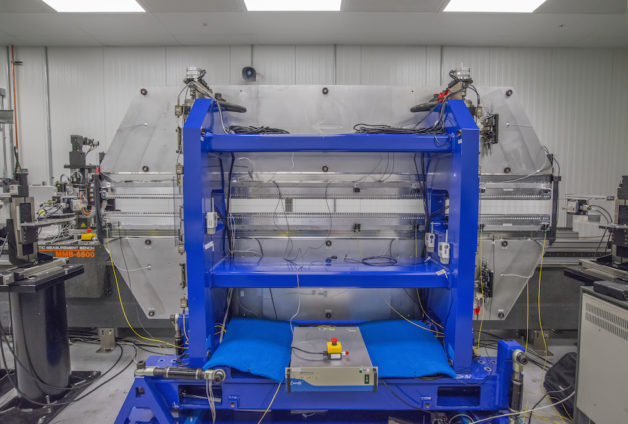
A prototype LCLS-II soft X-ray undulator, which is designed to wiggle electrons, causing them to emit brilliant X-ray light, undergoes magnetic measurements at Berkeley Lab. (Credit: Roy Kaltschmidt/Berkeley Lab)
Corlett added, “This is a major achievement—the culmination of years of work in designing the undulator, qualifying the design, and working with vendors.”
Berkeley Lab is also overseeing the final design and mass production of a set of 32 hard X-ray undulator segments, The Lab collaborated with Argonne National Laboratory in the design and development of these segments. (“Hard” refers to higher-energy X-rays, and “soft” refers to lower-energy X-rays.) Undulators using permanent magnets were first used for storage ring light sources and are now in use for free-electron lasers. The late Klaus Halbach of Berkeley Lab was a pioneer in developing the permanent-magnet array used in these devices.
Berkeley Lab is also fabricating a unique electron “gun” that kick-starts the rapid-fire electron bunches needed to produce intense electron beams for LCLS-II. The new gun is derived from the Advanced Photoinjector Experiment (APEX) gun, which was successfully developed at Berkeley Lab and is now being used for ultrafast electron experiments.
As the electron beams go through the undulators, the alternating magnetic fields inside will cause electrons to wiggle, giving off some of their energy in the form of light. As the beam goes through the long chain of undulator segments, each precisely spaced field adds to its intensity.
The soft X-ray undulator will be capable of producing up to 1 million soft X-ray pulses per second, and the hard X-ray chain can produce X-ray laser pulses that are up to 10,000 times brighter, on average, than those of the existing LCLS.
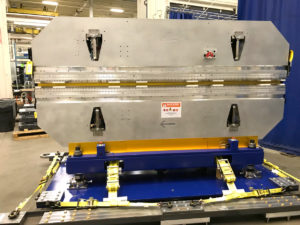
This image shows one of the first production soft X-ray undulator segments as it is prepared for shipment. At the device’s center are rows of magnets that will wiggle electrons to emit intense X-rays for use in a variety of experiments. The arrows on the device indicate the direction that the electrons and X-rays will travel through the device. (Credit: Keller Technology Corp./KTC)
“Tremendous effort has gone into the design and development of these undulators at Berkeley Lab and across the project collaboration,” said James Symons, associate laboratory director of Physical Sciences at Berkeley Lab. He oversees both the Engineering and the Accelerator Technology and Applied Physics divisions, which worked together to design and prototype the undulators. “We, and the X-ray user community, are looking forward to their installation and to ‘first light’ at LCLS-II.”
Wim Leemans, director of Berkeley Lab’s Accelerator Technology and Applied Physics Division, added, “It’s exciting to see the undulators move from the drawing board to the delivery truck after all those years of work. We are glad to contribute our expertise to this realization of a unique new tool for science.”
Berkeley Lab engineer Matthaeus Leitner has key technical and budgetary responsibility for the undulators, while his colleague Steve Virostek plays the same role for the injector system. Other Berkeley Lab contributions to LCLS-II include accelerator physics and technology studies in beam dynamics, free-electron laser design, the low-level radiofrequency system, and the management and integration of cryogenics systems.
John Galayda of SLAC, director of the LCLS-II project team, said, “The LBNL team’s performance has been crucial to the LCLS-II project’s good progress to date.”
This movie introduces LCLS-II, a future X-ray light source. It will generate over 8,000 times more light pulses per second than today’s most powerful X-ray laser, LCLS, and produce an almost continuous X-ray beam. (Credit: SLAC National Accelerator Laboratory)
The soft X-ray undulator shipments will continue every six weeks to SLAC from their assembly at a vendor in Buffalo, N.Y. The shipments will wrap up in spring 2018. To prevent damage and misalignment during their coast-to-coast journey, the undulator segments are being shipped in a climate-controlled truck that includes a special shock-absorbing frame.
Once delivered to SLAC, the undulator segments must be fine-tuned. “The undulators have been specially designed to allow for very rapid tuning,” said Henrik von der Lippe, Berkeley Lab’s Engineering Division director. “The process will require as little as two days, compared to the two weeks or more needed by earlier undulators.”
Now that the soft-X-ray undulator segments are in production, engineers are now conducting magnetic tests on a pre-production version of a hard X-ray undulator segment. These segments will be assembled by vendors in Buffalo, N.Y., and in Los Angeles, and then shipped to Berkeley Lab for tuning before final delivery to SLAC.
Work on the LCLS-II undulators is supported by the DOE Office of Science.
Read a related article: Berkeley Lab Working on Key Components for LCLS-II X-ray Lasers.
# # #
Lawrence Berkeley National Laboratory addresses the world’s most urgent scientific challenges by advancing sustainable energy, protecting human health, creating new materials, and revealing the origin and fate of the universe. Founded in 1931, Berkeley Lab’s scientific expertise has been recognized with 13 Nobel Prizes. The University of California manages Berkeley Lab for the U.S. Department of Energy’s Office of Science. For more, visit www.lbl.gov.
DOE’s Office of Science is the single largest supporter of basic research in the physical sciences in the United States, and is working to address some of the most pressing challenges of our time. For more information, please visit science.energy.gov.
